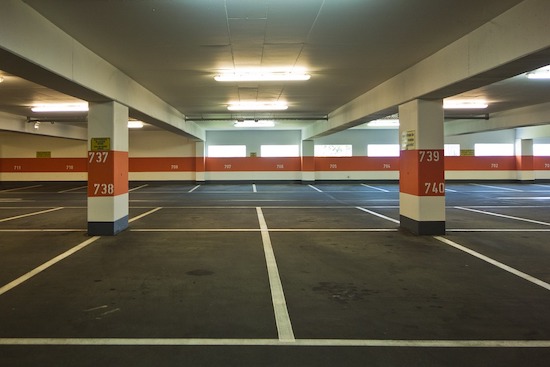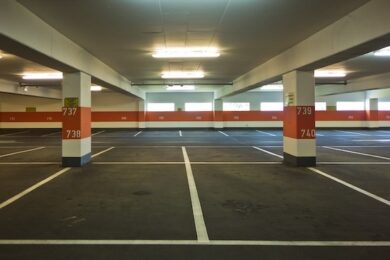It is Morrisons in Hastings that lights the fire of my obsession. Not the supermarket itself but the space outside: the car park. The attraction is not instant. We don’t click immediately. At first, I use Morrisons for the weekly shop, making me just like all the others who traipse between the superstore and the car, laden with bags or pushing a trolley, oblivious to the car park’s charms, its mystery, its threat. After a few months, I use Morrisons not only to shop, but also as a shortcut into town. Its car park lies at the other side of an underpass at the end of my road, between a railway embankment and a Victorian street of shops and eateries at the foot of West Hill, a steep elevation behind the Norman castle. I pass through it daily on my way to ostensibly more interesting destinations: the working fishing beach, the pubs, the chippies, the bric-a-brac shops.
One night, I return from the pub and take my usual shortcut through the Morrisons car park. But rather than head directly to my road, I take a look around. I am in no rush and there’s something alluring about the car park tonight, caught in bright moonlight after rain. Hooded lamps, crested with gull-deterring needles, shower light onto the tarmac. The yellow glow of the Morrisons sign, reflected in a puddle, has all the sad beauty of a late-night amusement arcade. I slap my foot in the water and see the stars wobble. ‘Moondance’ by Van Morrison kicks off in my brain. The night’s magic seems to whisper and hush as a herring gull boomerangs over the architraves and the ghost of a cleaner flits through the dimly lit interior. Vehicles are scattered here and there. A superstore car park is rarely empty, and never silent. Water trickles from the guttering. A generator hums. There is a squeak of trolley wheels and the rattle of something moving on metallic rails. A slam and bang. Bakers, perhaps, preparing the morning’s batch. The disembodied voices of the night shift drift across the lots as I wander in transgressive loops, crossing white lines, disabled parking bays and the petrol forecourt, where I send a startled fox crashing into the hedge. This seems a different, wilder car park to the one in the daytime.
There are others here. By the wall, two boys with skateboards smoke joints beneath a NO SKATEBOARDING sign as a huddle of girls pass around a can of Monster energy drink. A dented sports car rumbles down the access road, driver in a baseball cap, eyes lit up like a cat’s in the lamp glare before he veers off into the shadowy perimeter for a reason I cannot fathom, nor dare to discover. Three lanky Polish lads by the entrance talk in low voices and shoot me a dirty look as I veer towards the recycling bins at the perimeter, where a bed frame lies in the shrubs. I pass a Mercedes with a crumpled bonnet and, disconcertingly, a licence plate that includes the number 1066. As I turn back to the supermarket I approach a car with a solitary woman inside. She fumbles with her keys in panic. I pretend to look at my phone so that she knows I have no interest in what she’s up to. When I take a glance back she is twisted around in her seat, staring at me, wide-eyed. We remain connected for a torturous moment before she fires up the engine and pulls away. I get a strange sense that I have stumbled into a drama that connects the woman in the car, the lingering Polish men, the stoned skateboarders and the crashed Mercedes. There are secret lives that hide in plain sight.
At the rear hedgerow of the car park I notice a sign, which reads:
THIS DEVELOPMENT IS NOT DEDICATED AS A PUBLIC RIGHT OF WAY
ENTRY IS ONLY PERMITTED TO SHOPPERS AND THOSE WITH THE WRITTEN PERMISSION OF Wm MORRISON SUPERMARKETS PLC
PROCEEDINGS WILL BE TAKEN AGAINST THOSE ENTERING ONTO THIS DEVELOPMENT FOR ANY OTHER PURPOSE
It strikes me that I have entered the car park without any intention to shop, an illegal act in the eyes of the supermarket. The public are not permitted to walk or linger or play here. Proceedings might be taken against them. It feels like a challenge. Car parks are not only places for cars but also thoroughfares for pedestrians. Hangouts for teenagers. They’re places to rendezvous. Bump into neighbours. Exchange goods. Get some cash out. Have an argument with your partner. Make an awkward phone call. Eat a quiet lunch away from your colleagues. Secretly munch into a diet-busting burger from that chain you tell everyone you hate. Car parks are an intrinsic part of the landscape, like them or not, and if they are going to encroach on the space where our common grounds, marketplaces, municipal buildings, factories and marshlands once were, then we have a right to interrogate the space, find a way to embrace it, even learn from it. What do we even know about these places? Are they simply slabs of tarmac or are they something more? Do they have the potential to contribute something of worth to society? Or are they pernicious entities, Trojan horses of neo-liberalism, ruining us from the inside? Sites of psychosis, decay and disaster? Someone needs to find out, and this kind of landscape is right up my street. In the same way that a rambler who walks the same route regularly through private land can convert it to a public right of way, given enough time, perhaps I can do this with retail chain store car parks, and help reclaim the space for the good of all.
This is the moment when the car park nonsense, as friends and family describe it, takes over my life. I don’t know yet how many hours I will lose to car parks, how many cheeky car park diversions I’ll take on the way to someplace else. I don’t know yet that talking incessantly about car parks and arranging a week-long holiday around a series of car park visits between Hastings and the Scottish Highlands will contribute to the end of my marriage, but I cannot change that future. When the iceberg broke away and the Titanic set sail, the two had already converged. In this Morrisons at night, time and space conjoin, and the car-park-me is born. As I savour the thrill of a landscape mutating in significance before my eyes, I realise that a car park can have as much mystery and magic as a mountain, meadow or lakeside. When we hurry through them with groceries on our mind they may look indistinguishable, but like a second-hand book where the previous owner has scrawled notes in the margins, they are full of intriguing human detail. Examine them closely and they come to life. This challenges an assumed truth, that car parks are non-places without geography, nature, social history or cultural nuance. Here, beneath the Norman castle, circled by gulls, with the 1066 Mercedes and the bored teenagers, I feel that I couldn’t be anywhere else, and that here is not only a Morrisons, but a multiplicity of places reaching back through time.
In the eleventh century, when Hastings was a Cinque port, this spot would have been at the marshy edge of a bay that give shelter to ships. After cataclysmic storms in the thirteenth century, half the castle collapsed into the bay and caused it to silt up, ending Hastings’ role as a locus of sea power. Things took a turn during the late eighteenth-century bathing craze when it became a hotspot for rich folk seeking recuperative waters and salty air. The location of this Morrisons car park became the site of a waterworks and the Hastings & St Leonard’s Gas Company. The buildings that fronted Queens Road were known locally as ‘the Gas Showrooms’ and included an arched entrance into the works, inscribed with the words: Our Motto is Service. As the population grew and gas consumption soared, the site became too small. When the council demanded a £4,000 coal levy, the company’s shareholders voted to move the works to Bexhill. Only the Gas Showrooms remained, a series of red-brick buildings with a tower that jostled for supremacy with the neo-Gothic steeple of St Andrew’s Church next door, the interior of which was decorated by local tradesman Robert Tressell, who would write The Ragged-Trousered Philanthropists, a novel about the plight of working-class people in a fictional version of Hastings. His book describes the shady dealings of the gas company owners who moved the works to line their own pockets, which gives this car park location a cameo role in the town’s radical history.
When the gasometers and tower were levelled in the 1970s, a supermarket was established. On the site of the Victorian church, they built a petrol station in the service of our oil gods. The location of the arched entrance to the Gas Showrooms became the access road to the superstore. On occasions when I walk the dog up West Hill and look down at Morrisons, nestled in the valley by the railway line, I see the ghostly outline of its past: the roofs of amassed vehicles glistening like water in the former marshland; the clocktower on the superstore roof counting the hours until home-time for the gas workers; shoppers solemnly filing into the entrance by the petrol station like Victorian worshippers on a Sunday; cars trailing down Waterworks Road ready to stock up for the week; the corporation still trying to impress upon the locals its benevolent intentions. Our Motto is Service… Morrisons Makes It. This Morrisons has retained its genius loci as a place of energy, power and influence. It feeds the town with nourishment and fuel; it brings people together. Along the front of the store, benches are placed next to ashtray bins, rows of smokers gazing at car park life going by. There is the sound of chatter. Teenagers laughing. Parents telling their kids off. A sulking dog, tethered to the wall. An elderly couple eating Scotch eggs while waiting for their taxi. The trolley collector clattering past with his precarious train of steel. There are maps of Hastings, Bexhill and Battle on the wall. Taxi numbers and ads for local businesses. You don’t get as much sense of community in the car park of a Lidl or an Aldi. The new wave of budget car parks doesn’t encourage dwelling. There’s nowhere to sit. No advertising. No bins for cigarette ash. No car park attendants. These newcomers dispense of such wasteful fripperies. It makes me sad. Perhaps one day I will look back on my life and remember the car parks of Morrisons with a strange, sentimental yearning.
Car Park Life by Gareth E. Rees is published by Influx Press



